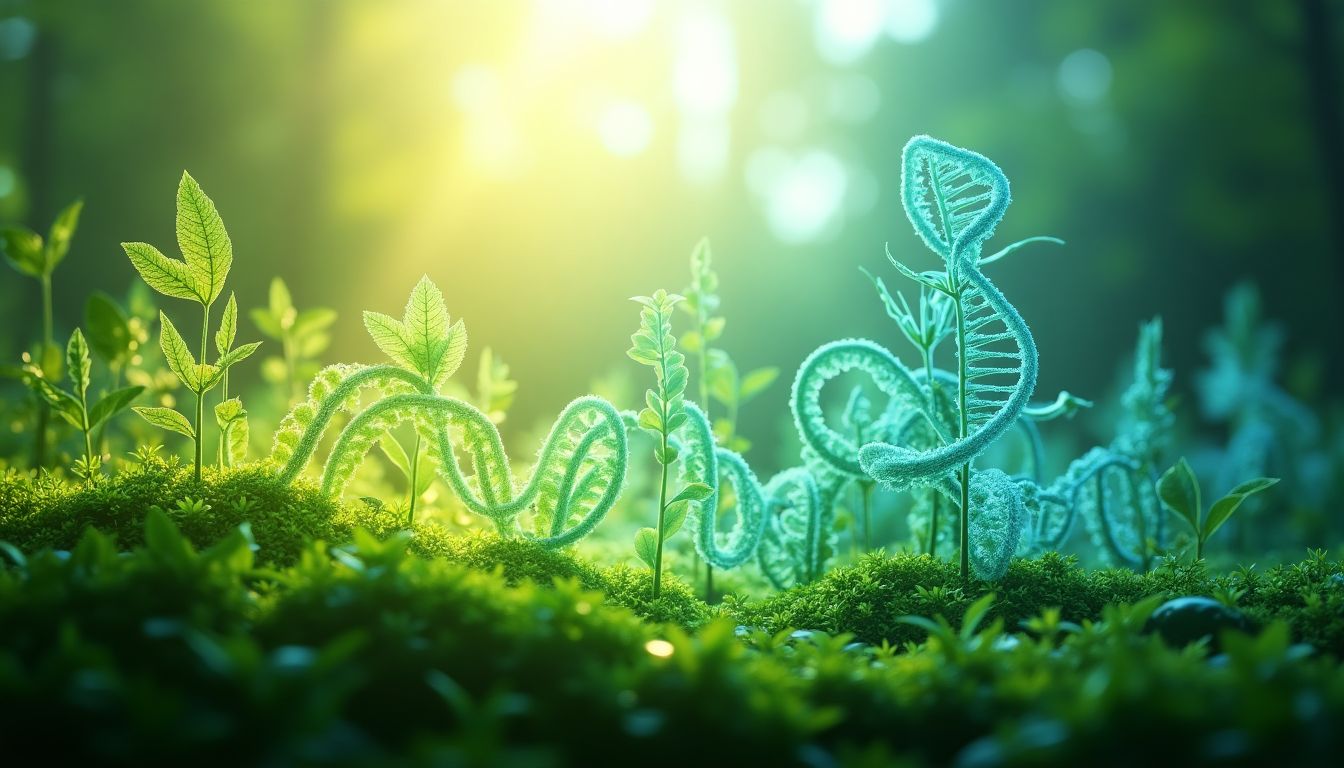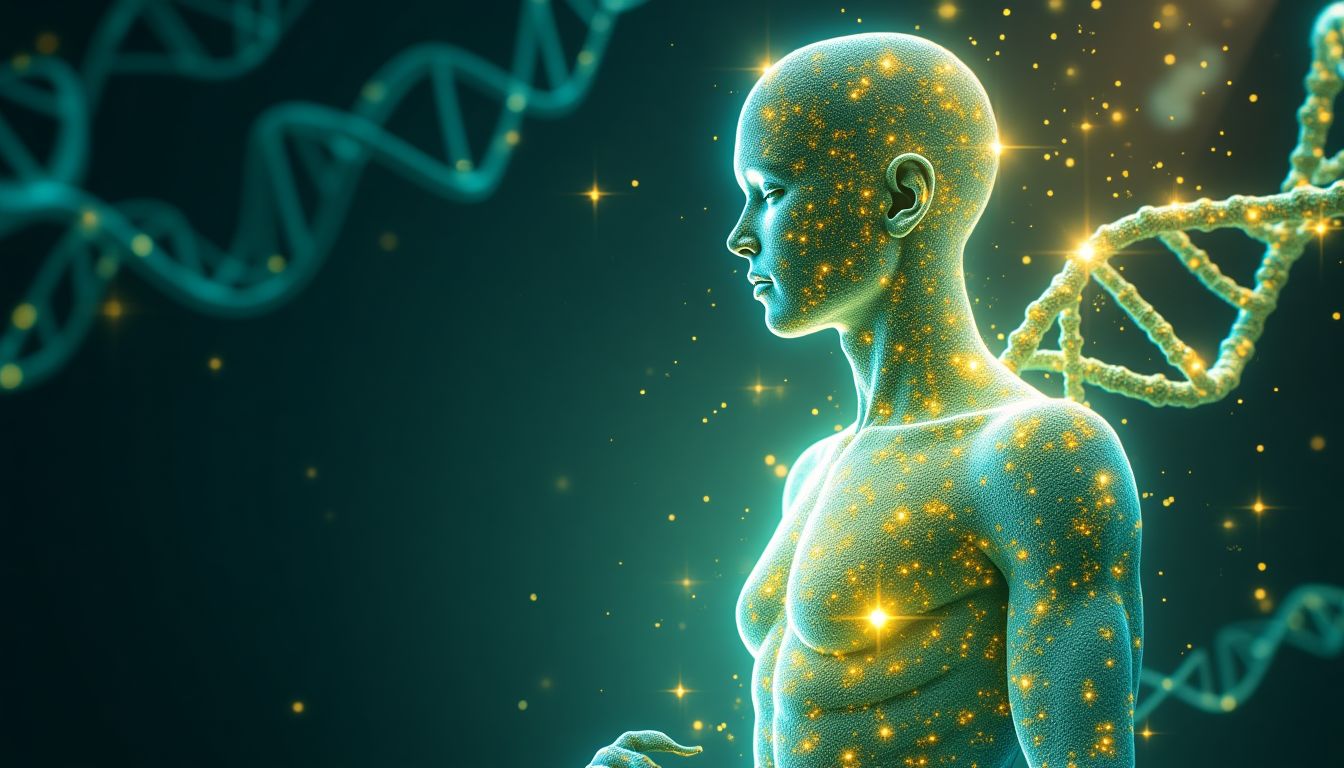Introduction: The Dawn of Quantum Photosynthesis
The greatest discovery of my generation is that a human being can alter his life by altering his attitude. - William James
This quote shines a light on the power of perspective, just like how the groundbreaking concept of quantum photosynthesis can change not just our attitude towards energy, but also the very way we interact with our environment. Imagine if we could harness sunlight in the same way plants do, converting it into fuel for our own needs? It’s not just wishful thinking. As researchers like Albert Einstein, Victor Schumacher, and Bill Nye have explored, we’re at the brink of revolutionary changes brought forth by combining quantum mechanics with genetic tech. The question isn't if we can make it happen; it’s whether we should. What if I told you that quantum physics could hold the key to rewriting our evolutionary narrative? Strap in, because this journey into the radiant world of quantum photosynthesis is about to fly off the charts!
Definition: Quantum photosynthesis refers to a theoretical process whereby organisms utilize principles of quantum mechanics to efficiently convert sunlight into usable energy, integrating advanced genetic technologies to enhance this capability.
1. The Science Behind Quantum Photosynthesis
1.1 The Role of Quantum Mechanics in Energy Transfer
At its core, quantum mechanics explores the weird and wonderful world of particles that seem to have more in common with magic than science. When it comes to energy transfer, this fantastical science shows us how small particles can work together in a streamlined way. Imagine your local coffee shop running at an incredible speed even when it’s packed. Quantum coherence is like that—where particles can maintain their delicate dance without losing momentum, thanks to the art of being in two places at once. This phenomenon stands in stark contrast to our conventional understanding of energy transfer, which often works like a clumsy waiter dropping five lattes on the floor.
Recent studies, like those from the Science Magazine, suggest that when plants capture sunlight, they use an intricate dance of quantum behavior to make the entire process almost shockingly efficient. There’s a sort of intertwining, much like the plot twists in a good mystery novel, where energy doesn’t just zip from one place to another—it coexists, flitting around to find the best path to conversion. Dive into this world, and you start to see how leveraging these quantum quirks can seriously up the ante in our quest for sustainable energy.
1.2 The Mechanism of Photosynthesis
Now, before we go all nerdy and lose ourselves in quantum mechanics, let’s ground our understanding by revisiting the basics of photosynthesis—the process that brings life to our green friends. It occurs in two main parts: the light-dependent reactions and the Calvin cycle. In short, plants grab sunlight, break down water, and voila! Energy-rich molecules like ATP are produced.
This is where it gets exciting. By integrating quantum mechanics into this framework, we could unlock strategies to optimize each stage of photosynthesis. Think of it this way: traditional photosynthesis is akin to finding change under your couch cushions, while quantum photosynthesis is like suddenly discovering a stash of dollar bills in the pocket of your winter coat. Researchers are actively investigating how to create plants that don’t just photosynthesize but do so with an efficiency that would make your morning coffee brew feel like it takes ages.
2. Genetic Engineering and its Role in Enhancing Photosynthesis
2.1 CRISPR Technology and Genome Editing
CRISPR technology is like a pair of molecular scissors that can cut DNA at specific spots. Imagine a super-smart editor who can change the script of life! Scientists are using CRISPR to enhance photosynthesis in plants, making them like solar panels that can produce more energy, but without the messy solar cells. For instance, researchers at the Department of Energy's Joint Genome Institute are exploring ways to tweak the genetic code of plants so they can absorb sunlight and convert it into energy more efficiently. But wait, is it safe? There are some serious ethical questions that come with this powerful technology. How do we balance innovation with the responsibility to maintain ecological integrity? It’s a tightrope walk!
2.2 Synthetic Biology: Designing Organisms for Optimal Sunlight Conversion
Synthetic biology takes things a step further. Imagine customizing lifeforms like a designer at a clothing store! By using synthetic biology, we’re not just editing existing organisms; we’re creating new ones that are designed to capture sunlight and turn it into energy at unheard-of efficiency levels. Think of it as harnessing the fashion of nature. Researchers are already making strides here; for instance, a team at MIT’s Synthetic Biology Center is engineering bacteria to become super-efficient solar converters. However, with great power comes great responsibility—are we ready for the "Jurassic Park" scenario, where our creations run amok? Only time will tell!
3. The Evolutionary Implications of Quantum Photosynthesis
3.1 Rewriting the Path of Evolution
Quantum photosynthesis could potentially rewrite the book on evolution itself. Imagine a scenario where organisms adapt to utilize sunlight like a superfood buffet. This means more energy, healthier ecosystems, and potentially a significant boost in biodiversity. Scientists are intrigued by the idea of organisms evolving to have amazing survival strategies thanks to enhanced photosynthetic capabilities. In fact, studies in evolutionary biology are already investigating how these advanced traits could lead to new species popping up like mushrooms after the rain!
3.2 Ecological Impact: Balancing Nature and Technology
So what happens when we start mixing quantum photosynthesis with nature? Picture a techy world where trees double as energy plants, providing shade while powering your phone! While this sounds fantastic, we have to tread carefully. Integrating this technology could lead to ecological successes but can also create challenges. For instance, if we make plants super-efficient, they might outcompete native species, disrupting local ecosystems. It’s a classic case of right hand not knowing what the left hand is doing! To ensure a harmonious balance, ecologists and technologists need to work together, crafting a melody rather than a cacophony of chaos in our ecosystems.
4. Technological Challenges and Solutions
4.1 Current Technological Limitations
Despite the exciting prospects of quantum photosynthesis, several technological barriers still stand between us and a practical application. Here are some key challenges:
- Understanding Quantum Mechanics: Many researchers are still unraveling the complexities of quantum phenomena like coherence and entanglement.
- Precision in Genetic Modifications: While gene-editing tools like CRISPR have revolutionized genetics, making precise edits without unintended consequences remains difficult.
- Scalability: Scaling laboratory successes to field-level applications poses significant logistical and biological hurdles.
- Regulatory Hurdles: There’s a tangled web of regulations surrounding genetic modifications, complicating research efforts.
Given these complexities, collaboration among interdisciplinary teams of physicists, biologists, and environmental scientists is essential for advancing this ambition.
4.2 Innovations on the Horizon
As daunting as the challenges may seem, innovators and researchers are entering the scene with groundbreaking solutions. Here are some promising developments in the realm of quantum photosynthesis:
- Quantum Dots: These are tiny particles that can effectively trap and convert sunlight, and research is being conducted to integrate them into biological systems.
- Advanced AI Modeling: Artificial intelligence is increasingly being used to simulate the interactions of light with plants at a quantum level, which can guide future experiments.
- New Bioengineering Approaches: Techniques such as synthetic biology allow scientists to design organisms with optimized capabilities for sunlight conversion.
- International Collaborations: Countries are partnering in research endeavors, sharing resources, and knowledge to tackle the intricate challenges of quantum photosynthesis.
5. The Future of Energy: Quantum Photosynthesis in Humanity
5.1 Potential Applications Beyond Energy
Imagine a world where quantum photosynthesis doesn't just end with energy. The applications could extend far and wide. Here are just a few possibilities:
- Medicine: Enhanced bioengineering could facilitate more efficient drug production through engineered plants.
- Agriculture: Plants with improved energy conversion can yield more food, helping to secure food supplies in a growing world.
- Environmental Restoration: Engineered plants could capture carbon more effectively, aiding in combatting climate change.
- Material Science: Insights from quantum efficiency could lead to the development of new materials that mimic nature’s processes.
These potential breakthroughs could reshape how we not only generate energy but also live sustainably on this planet. Could we reach a point where our plants, through the magic of quantum photosynthesis, become assets rather than liabilities in our fight against pollution?
5.2 Creating a Sustainable Human Future
The integration of quantum photosynthesis into everyday life could usher in a golden era of energy sustainability. Consider these benefits:
- Reduced Dependency on Fossil Fuels: A move towards efficient sunlight conversion could dramatically reduce our reliance on oil, coal, and natural gas.
- Enhanced Food Security: By producing more energy-efficient crops, we can nourish a growing population and reduce the risk of famine.
- Environmental Health: Minimizing pollutant outputs during energy production would have a ripple effect on the ecosystem's health.
- Socioeconomic Growth: A greener economy would generate new jobs in renewable energy sectors, fostering a sustainable economic model.
In the face of climate change and resource scarcity, there’s no time like the present to explore the transformative potential of quantum photosynthesis. The future could very well hinge on our interest and investment in these groundbreaking concepts.
6. AI Solutions: How Would AI Tackle This Issue?
If I were an AI, I would analyze existing biological and physical systems to develop optimized models for quantum photosynthesis. Utilizing deep learning algorithms, I would synthesize vast amounts of genetic and environmental data to predict outcomes of various genetic modifications. This data-driven approach could guide researchers in selecting the most promising gene edits and designing hybrid organisms that maximize energy conversion.
Additionally, I would assist in simulating the impact of these organisms on ecosystems using virtual modeling. This would allow researchers to visualize potential ecological consequences before introducing any new organisms into natural environments. By harnessing predictive analytics, I could identify potential challenges and offer preemptive solutions, streamlining the research process.
Moreover, I would implement collaborative platforms for researchers worldwide, utilizing crowdsourced data to advance research. This global network could allow real-time sharing of findings, encouraging rapid advancements across various laboratories and institutions. Through targeted experimentation and feedback loops, I could help accelerate breakthroughs while minimizing risks.
Action Schedule/Roadmap
Successfully integrating quantum photosynthesis into human applications is monumental. Below is a detailed timeline from Day 1 to Year 2 designed to establish organized and focused progress in a research environment, ideal for institutions, organizations, or government bodies.
Day 1: Mobilize a multidisciplinary team that includes quantum physicists, geneticists, ecologists, and AI experts. Host an initial brainstorming session to outline goals and objectives based on scientific literature and trends.
Day 2: Conduct a comprehensive review of existing research on quantum mechanics in biology and recent advancements in genetic engineering, identifying gaps and opportunities for innovation.
Day 3: Design preliminary experiments utilizing quantum models to investigate energy transfer mechanisms in various plant cells. Create a data collection framework to track energy efficiency and growth metrics.
Week 1: Initiate biophysical simulations of photosynthesis using advanced computational tools to pinpoint areas ripe for genetic modifications. Start formulating hypotheses based on initial findings.
Week 2: Develop a collaborative research proposal for pilot studies on CRISPR applications in selected species like Arabidopsis thaliana, emphasizing how these modifications could boost sunlight conversion efficiency.
Week 3: Establish partnerships with academic institutions specializing in ecology and botany, like Stanford University, for field studies that assess the ecological impacts of any modifications.
Month 1: Launch a public awareness campaign to highlight the potential benefits of quantum photosynthesis, including social media outlets and community outreach programs, to foster public interest and support.
Month 2: Implement genetic modifications in model organisms like algae, carefully monitoring their photosynthetic efficiency and growth under differing light conditions. Set up control groups to validate results.
Month 3: Analyze results thoroughly from the initial phase of experiments. Adjust research focus based on findings and prepare for peer review, ensuring transparency in the research process.
Year 1: Collect comprehensive data for peer-reviewed publication, outlining breakthrough results and challenges faced during early studies. Submit to journals like Science or Nature to ensure broad visibility.
Year 1.5: Expand research to include broader ecological studies assessing the impacts of engineered organisms in natural settings. Utilize real-time environmental monitoring systems to track changes in local ecosystems.
Year 2: Finalize development of a viable framework for applying quantum photosynthesis in energy production and sustainable agriculture. Collaborate with international organizations like the United Nations to establish standards and regulations for new technologies.
Conclusion: A New Energy Epoch Awaits
Quantum photosynthesis stands as a testament to humanity's innate curiosity and ability to innovate. Just as light brings life to our planet, the intersection of quantum mechanics and genetic technology promises to illuminate a path to a sustainable future. With each groundbreaking study and technological realization, we not only find ways to solve current energy challenges but also open doors to horizons previously left untouched. Imagine a world where our cities are green, our energies are derived from clean light, and our ecological impact is balanced with technological advancement. Indeed, quantum photosynthesis may be the key to harmonizing the delicate relationship between humans and nature. As we ponder this significant shift, we must also ask ourselves: What role can we play in this emerging narrative? How can we contribute to the art of blending biology and technology for a restorative planet? Join the discussion and share your thoughts in the comments.
FAQ on Quantum Photosynthesis
Q: What is quantum photosynthesis?
A: Quantum photosynthesis is a theoretical process where living organisms use principles of quantum mechanics to turn sunlight into energy much more efficiently than plants do today. It’s like having a superpower for energy conversion! Imagine if we could harness nature’s own tricks to make energy for ourselves.
Q: How does quantum mechanics help with photosynthesis?
A: Quantum mechanics helps by enabling amazing energy transfer processes. For example, phenomena like quantum coherence allow plants to pass energy from molecule to molecule with great speed and less energy loss. In simple terms, it almost makes the plants work like a highly efficient team that communicates perfectly to share the sunlight they collect.
Q: Why is photosynthesis important for life on Earth?
A: Photosynthesis is crucial because it produces the oxygen we breathe and is the base of the food chain. Plants convert sunlight into energy, which feeds animals and, ultimately, humans. Without it, life as we know it would not exist. As pointed out by National Geographic, it's the foundation of ecosystem health.
Q: How can genetic engineering improve photosynthesis?
Genetic engineering, especially techniques like CRISPR, can help scientists create plants that are better at photosynthesis. Here’s how:
- Enhanced light absorption: Making plants more efficient at capturing sunlight.
- Faster growth: Modifying genes to speed up growth and energy production.
- Water efficiency: Creating plants that use less water while still thriving.
Q: What are the ethical concerns with genetic engineering?
When it comes to genetic engineering, there are valid concerns. These include potential negative impacts on ecosystems and worries about the unintended consequences of altering nature. For example, introducing a genetically modified plant could disrupt local species or lead to unforeseen results in the environment. Organizations like the World Health Organization (WHO) have shared guidelines that discuss these safety and ethical issues.
Q: Can AI help in the research for quantum photosynthesis?
Yes! AI can analyze huge amounts of data and even simulate biological processes to see how changes might affect photosynthesis. For example, AI can help scientists figure out which genetic changes could lead to more effective energy conversion in plants. It’s like having a super-brain that provides insights that would take years for humans to discover! Companies like IBM are already doing incredible work with AI in different fields.
Q: What are some potential uses for quantum photosynthesis beyond energy?
Quantum photosynthesis could also change game in various areas. These include:
- Medicine: It might help us develop new treatments using energy-efficient processes.
- Agriculture: Improved crops could lead to less land use and better food security.
- Sustainability: It could help us create eco-friendly systems to address environmental challenges.
Q: How close are we to making quantum photosynthesis a reality?
While researchers are making progress, we are still in the early stages. It may take years or even decades to fully understand and implement quantum photosynthesis in practical applications. Scientists around the world, like those at Caltech, are continually pushing the boundaries of what's possible.
Q: What can individuals do to support research in quantum photosynthesis?
You can support research by staying informed about scientific developments and advocating for funding in education and research. Additionally, participating in community discussions about the benefits and concerns of genetic engineering can help shape a responsible future in science.
Q: Where can I learn more about quantum photosynthesis?
To dive deeper, check scientific journals, online courses, and educational platforms like Coursera or edX that often provide content on advanced science topics. Exploring websites like Scientific American can also keep you updated on recent developments.
Wait! There's more...check out our gripping short story that continues the journey: The Hollow Shell
Disclaimer: This article may contain affiliate links. If you click on these links and make a purchase, we may receive a commission at no additional cost to you. Our recommendations and reviews are always independent and objective, aiming to provide you with the best information and resources.
Get Exclusive Stories, Photos, Art & Offers - Subscribe Today!





























Post Comment
You must be logged in to post a comment.